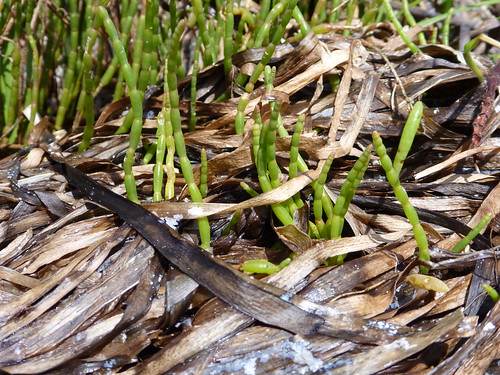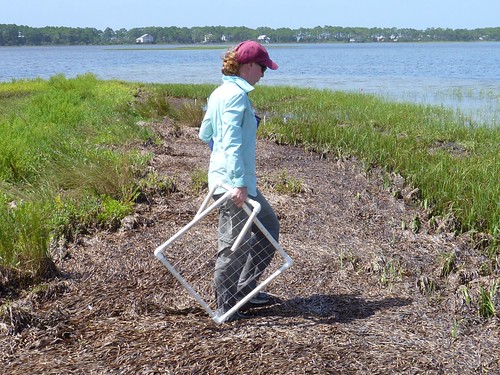Dr. Randall Hughes FSU Coastal & Marine Lab
 Since my last post, oil has stopped spewing from the Deepwater Horizon well, a very welcome development in what has been a long and grim story. Although it is tempting to feel that we are out of the woods, all one needs to do is consider the amount of oil that has entered the Gulf to realize that it will be a long time before we fully understand the ecological impacts of this disaster, much less fully recover from it.
Since my last post, oil has stopped spewing from the Deepwater Horizon well, a very welcome development in what has been a long and grim story. Although it is tempting to feel that we are out of the woods, all one needs to do is consider the amount of oil that has entered the Gulf to realize that it will be a long time before we fully understand the ecological impacts of this disaster, much less fully recover from it.
That said, the probability that the marshes I study in St. Joseph Bay and Apalachee Bay are going to be directly impacted by oil has declined dramatically. You may wonder, were our efforts to collect “pre-oil” data wasted? The answer is no, for a number of reasons:
1. Though the marshes my lab and I have studied will likely not be highly impacted by oil, there are large expanses of marshes that already are, particularly in Louisiana. Comparisons of oiled sites in one geographic area with un-oiled sites in another area are certainly not ideal, but having data from “natural” marshes over the same time period that data are taken from oiled marshes could be useful for assessing impacts and/or promoting recovery.
2. Even if we don’t get visible blobs of oil at our sites, there are still a number of ways that they could be affected by the spill. For instance, scientists in Louisiana have found evidence of oil and dispersant chemicals under the shells of crab larvae, suggesting that these chemicals will likely be incorporated in the food chain – the larvae (and the oil) will be consumed by larger crabs and fish, who will in turn be consumed by other predators, and so on. This finding is just a reminder of one of the many ways that oil could find its way into the marsh community, and further evidence for the need for data in the absence of oil.
3. The surveys we conducted this summer to collect pre-oil data were originally part of our summer plan for a different reason: to evaluate the effects of seagrass wrack on salt marsh communities. (Although we modified our methods slightly to increase our ability to assess oil impacts – for example, by taking soil hydrocarbon samples – the data still serve their original purpose.) Seagrass wrack is a natural feature of marsh communities in this area, consisting of dead seagrass leaves that are sloughed off as seagrasses continue to grow.
Wrack is often deposited in mats along the high tide line of the marsh, particularly in the summer when seagrasses are growing (and shedding leaves) more rapidly. If these mats of wrack stick around long enough, they can kill the underlying marsh plants. Though a negative for the plants that are directly affected, this open space can allow seeds of new plants to recruit into the area. In addition, as the wrack decomposes, it can add needed organic matter to the sediment that can promote future plant growth.
Because wrack has both positive and negative effects on salt marsh plant communities, it is not clear what the overall impact is. In addition, relatively little is known about how wrack affects the insects and marine invertebrates that live in the marsh, or how these animals may influence marsh plant and wrack interactions. My graduate student, Emily Field, is interested in these questions, and so she has been leading the charge this summer to survey marsh plant and animal populations, along with wrack abundance, at our sites in St. Joe Bay. We’ll use our observations and the data collected this summer to design future experiments on the effects of seagrass wrack on salt marsh communities.
So although we hope to use our marsh surveys to look at wrack effects instead of oil effects, either way we’ll keep collecting data, and keep crossing our fingers that the oil well stays capped until completely plugged!



6 comments
[…] my research in salt marsh habitats, with mention of seagrasses only in the context of their role as wrack in the salt marsh. However, I’m also interested specifically in seagrasses and the community of […]
[…] growing out in the bay has sloughed off its older blades and grown new ones. Those blades land on the salt marsh in mats that end up killing cordgrass and making clearings. Coming up on one of these clearings, fiddlers […]
[…] Emily will continue her surveys of the effects of seagrass wrack on salt marsh plant and animal communities, and she’ll also […]
[…] meantime, I refer you back to Randall’s post on seagrass beds and epiphytic algae, and her post (with a video hosted by graduate student Emily Field) on Emily’s study of seagrass wrack, the […]
[…] Learn more about Emily’s seagrass wrack study. […]
[…] a phenomenon we’ve covered on this site before, is the dark green or brown grasses on the beach and is often mistaken for dried, dying […]
Comments are closed.